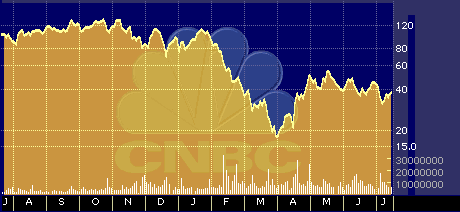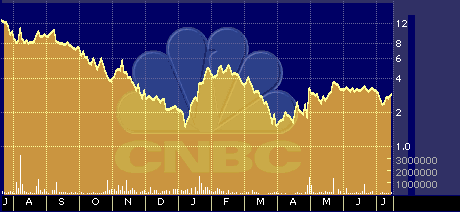
Need for Speed Sends Two Stocks Soaring
Need for Speed Sends Two Stocks Soaring
by Hal Plotkin
Silicon Valley Correspondent
Brocade Communications Systems Inc. {BRCD} and Gadzoox Networks Inc. {ZOOX} are benefiting from soaring demand for storage area networks (SAN) — the newest stretch of high-tech pavement on the fast-growing information superhighway — which could pose an obstacle for the networking industry’s big gun Cisco Systems Inc. {CSCO}, if it wants to enter the SAN market.
The overall market for SANs is expected to skyrocket to more than $16.4 billion by 2002, according to Dataquest, based in San Jose, Calif.
The growth in the SAN market is occurring because earlier networking technologies are being overloaded by ever-increasing amounts of data. The advent of data-intensive Internet applications, such as streaming video, has helped push the SAN market into hyperdrive. Unlike previous server technology, which typically used one data-storage unit per server, SANs allow companies to use multiple super-fast storage devices with multiple servers.
Sun’s Magic Is Its Servers by Hal Plotkin
Companies using SAN’s fiber-optic transport method, called “fibre channel,” can store and process more than seven times the amount of data at about one-fourth the cost of previous systems, according to a recent study by International Data Corp., based in Framingham, Mass. What’s more, due to built-in redundancy features, SAN systems offer far greater reliability.
The recent run-up in the stock prices of leading SAN makers “is a reflection of a real market opportunity,” says Roger Cox, chief analyst at Dataquest. “Brocade in particular has garnered a tremendous market share,” he says. “They’ve put together deals with nearly all the major server vendors.”
Cox says that helps explain why San Jose, Calif.-based Brocade’s shares have zoomed about eight-fold since the company’s very successful May 1999 initial public offering. Brocade’s stock took another big leap after the company reported record fiscal third-quarter revenue of $20.1 million on Aug. 12, a 339 percent increase over the same quarter last year. Brocade’s net income for the period was $1.6 million, as compared with a net loss of $8.1 million in the fiscal third quarter of 1998.

BRCD stock price chart since its IPO
But don’t count out Brocade’s competitors, including Gadzoox just yet, says Paul J. Weinstein, an analyst at Credit Suisse First Boston, based in San Francisco.
Last Monday, Weinstein initiated his firm’s coverage of San Jose, Calif.-based Gadzoox with a strongly positive 32-page report that set a price objective of $85 to $95. “The traditional server-storage connection paradigm is breaking down and will be replaced by SANs owing to price performance, scalability, and reliability factors. Gadzoox possesses a broad product portfolio, a strong fibre-channel heritage, significant market share, and extensive management depth,” he wrote.
For the fiscal year ended March 31, Gadzoox posted revenue of $24.8 million and a loss of just below $16 million.

ZOOX stock price chart since its IPO
Weinstein says he isn’t at all troubled by recent reports that Brocade has inked deals with major original equipment manufacturer server vendors, including IBM {IBM}, NEC Corp. {NIPNY}, and Data General Corp. {DGN}, all of which will be bundling Brocade’s technology into their own product lines.
“The Brocade announcements don’t change the competitive dynamics or make me think differently,” Weinstein says. “Brocade’s clearly got a lot of OEMs, there’s no surprise there. But Gadzoox is more focused on open channels of distribution, which is a very good strategy, given the simplicity of their products.”
A Gadzoox spokesman says Brocade’s success doesn’t necessarily come at the expense of Gadzoox. “We sell equipment to many of those same customers,” says Dave Tang, vice president of marketing at Gadzoox.
Tang says different divisions in the same company, Hewlett-Packard Co. {HWP}, for example, often buy similar equipment from different vendors. Tang adds that Gadzoox recently created a global network of distributors and partners who are pushing product through the value-added resellers who typically put together Web sites and computer networks for corporate customers. “We are well ahead in that distribution channel,” he says.
Both companies are leading players in the race to create what San Francisco-based BancBoston Robertson Stephens analyst Paul Johnson calls “next-generation networks.”
Johnson recently created a Web site devoted entirely to tracking progress in the fast-growing field. He notes that several large telecommunications companies, including SBC Communications Inc. {SBC}, Sprint Corp. {FON}, GTE Corp. {GTE}, and Bell Atlantic Corp. {BEL}, have all recently committed themselves to building new networks capable of handling the growing avalanche of data traffic.
“This may be the most exciting period in the history of the telecommunications industry,” Johnson wrote.
Several other fibre-channel companies, including Bothell, Wash.-based Vixel Corp., which also has a distribution deal with IBM, and Minneapolis-based Ancor Communications Inc. {ANCR} which has a similar agreement with Sun Microsystems Inc. {SUNW}, are also benefiting from the SAN surge.
In terms of Cisco and the SAN market, “It’s a little surprising they didn’t get there first,” says Dataquest’s Roger Cox. But now, thanks to the complexity involved in writing software needed to control SANs, it might be tough for Cisco to catch up. “It could take them a good 18 to 24 months,” he estimates.
Cisco is “probably more likely” to buy its way into the SAN market, Cox says, by eventually scooping up one or more of the existing players. “The current market cap makes it expensive to buy Gadzoox or Brocade,” he says. “But [SAN companies] could be even more expensive in the future.”


